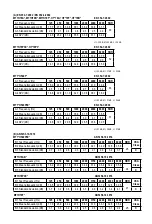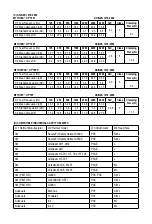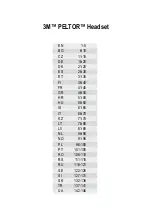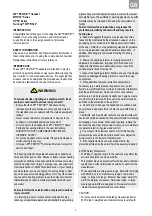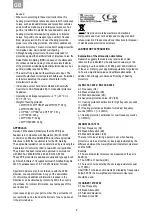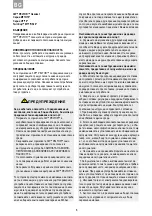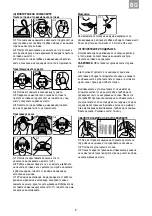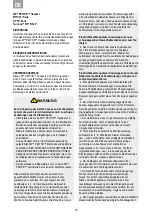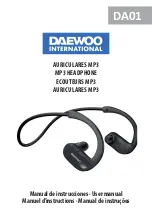
2
be used.
• When worn according to these User Instructions, this
hearing protector helps reduce exposure to both continuous
noises, such as industrial noises and noises from vehicles
and aircraft, as well as very loud impulse noises, such as
gunfire. It is difficult to predict the required and/or actual
hearing protection obtained during exposure to impulse
noises. For gunfire, the weapon type, number of rounds
fired, proper selection, fit and use of hearing protection,
proper care of hearing protection, and other variables will
impact performance. To learn more about hearing protection
for impulse noise, visit www.3M.com/hearing.
• Although hearing protectors can be recommended for
protection against the harmful effects of impulsive noise, the
Noise Reduction Rating (NRR) is based on the attenuation
of continuous noise and may not be an accurate indicator
of the protection attainable against impulsive noise such as
gunfire (wording required by EPA).
• This earmuff is provided with electrical audio input. The
wearer should check correct operation before use. If distortion
or failure is detected, the wearer should refer to the
manufacturer’s advice.
• In Canada, users of hard hats combined with earmuffs
must refer to CSA Standard Z94.1 on industrial protective
headwear.
• Operating and storage temperature: –4 °F (–20 °C) to
131 °F (55 °C).
• Weight of hearing protector:
o MT7H79A*, MT7H79B* and MT7H79F*: 381 g
o MT7H79P3E: 320 g
o HT*79A*, HT*79B* and HT*79F*: 381 g
o HT*79P3E: 320 g
o MT7*H540F*: 428 g
o MT7*H540P3E: 345 g
APPROVALS
Hereby, 3M Svenska AB declares that the PPE type
headset is in compliance with Regulation (EU) 2016/425
or Community Directive 89/686/EEC and other appropriate
directives to fulfill the requirements for the CE marking.
The applicable legislation can be determined by reviewing the
Declaration of Conformity (DoC) at www.3M.com/peltor/doc.
The product has been tested and approved in accordance
with EN 352-1:2002/EN 352-3:2002, EN 352-6:2002.
These PPE products are audited annually and type approved
by Finnish Institute of Occupational Health, Notified Body No.
0403, Topeliuksenkatu 41 b, FI-00250 Helsinki, Finland.
Specific models are also in conformance with the ATEX
Directive, see separate folder. A copy of the declaration
of conformity and additional information required in the
Directives can be obtained by contacting 3M in the country
of purchase. For contact information, see last pages of this
user instruction.
Upon request, type in your part number. The part number of
your earmuffs can be found at the bottom of one cup as seen
in the picture below.
This product contains electrical and electronic
components and must not be disposed of using standard
refuse collection. Please consult local directives for disposal
of electrical and electronic equipment.
LABORATORY ATTENUATION
Explanation of the attenuation data tables
Research suggests that users may receive less noise
reduction than indicated by the attenuation value(s) on the
packaging, due to variation in fit, fitting skill, and motivation
of the user. Refer to your applicable regulations for guidance
on how to adjust label values and estimate attenuation. In
addition, 3M strongly recommends fit testing of hearing
protectors.
(A) EN 352-1:2002 / EN 352-6:2002
A:1 Frequency (Hz)
A:2 Mean attenuation (dB)
A:3 Standard deviation (dB)
A:4 Assumed protection value, APV (dB)
H = Hearing protection estimation for high frequency sounds
(ƒ ≥ 2000Hz).
M = Hearing protection estimation for medium frequency
sounds (500Hz < ƒ < 2000Hz).
L = Hearing protection estimation for Low frequency sounds
(ƒ ≤ 500Hz).
(B) ANSI S3.19-1974
B:1 Test Frequency (Hz)
B:2 Mean Attenuation (dB)
B:3 Standard Deviation (dB)
The level of noise entering a person’s ear, when hearing
protector is worn as directed, is closely approximated by the
difference between the A-weighted environmental noise level
and the NRR.
Example
1. The environmental noise level as measured at the ear is
92 dB(A).
2. The NRR is 21 decibels (dB).
3. The level of noise entering the ear is approximately equal
to 71 dB(A).
CAUTION: For noise environments dominated by frequencies
below 500 Hz the C-weighted environmental noise level
should be used.
(C) AS/NZS 1270:2002
C:1 Test Frequency
C:2 Mean Attenuation
C:3 Standard Deviation
C:4 Mean minus SD
GB


